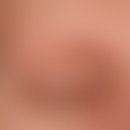Synonym(s)
DefinitionThis section has been translated automatically.
The "short anagen syndrome" was first published in 1991. Since then, only a few cases have become known. The cause of this benign hair growth disorder is unknown. Most published cases are single cases. A familial clustering has not been reported so far.
ClinicThis section has been translated automatically.
With the "short anagen syndrome" the duration of the anagen growth phase of the hair is reduced to 1-2 years, compared to a normal anagen growth cycle of 4-7 years. The hair growth disorder is noticed in early childhood and becomes noticeable when parents report that their child does not need a haircut and that the growth of hair does not come out over a certain length of hair.
Clinically there are no hair shaft abnormalities. Most children show light fine hair. However, dark-haired children have also been described. The hair shows a normal density, but is abnormally short without ever being cut. The hair shaft is normal, not fragile. The hair plucking test is normal. The hair is not "easily epilated" as is the case with loose anangelic hair syndrome .
You might also be interested in
DiagnosisThis section has been translated automatically.
In the trichogram one finds predominantly telogenic hair. This results in a clear difference to the "loose anagen syndrome" where almost exclusively anagen hairs can be extracted.
Further physical examinations are normal. No associations with tooth or nail dystrophies are detectable. There are no associations to a "Noonan-like syndrome" (see below: Loose anagen hair syndrome). Children with a "short anagen syndrome" have normal mental and physical development.
TherapyThis section has been translated automatically.
5% minoxidil solution 2x daily seems to be able to prolong the anagen phase. Its efficiency has so far only been proven in isolated cases.
Progression/forecastThis section has been translated automatically.
Many cases of "short anagen syndrome" persisted unchanged into adulthood. Thus, the disease contrasts in its prognosis with the "loose anagen hair syndrome", whose symptoms improve with increasing age. However, cases have also been described in which hair growth normalises postpubertal (Wolf 2017).
LiteratureThis section has been translated automatically.
- Antaya RJ et al (2005) Short anagen syndrome. J Am Acad Dermatol 53: 130-134.
- Avashia N et al (2010) Short anagen syndrome in an African American woman. J Am Acad Dermatol 63:1092-1093.
Barraud-Klenovsek MM et al (2000) Congenital hypotrichosis due to short anagen. Br J Dermatol 143:612-617.
Cheng YP et al (2016) Minoxidil improved hair density in an Asian girl with short anagen syndrome: a case report and review of literature. Int J Dermatol doi: 10.1111/ijd.12150.
- Dhepe NV et al (2012) Short Anagen Syndrome in an Indian Woman with its Impact on Quality-of-Life. Int J Trichology 4:271-272.
- Doche I et al (2012) Short anagen syndrome in a girl with curly dark hair and consanguineous parents. J Am Acad Dermatol 67:e279-280.
- Giacomini F et al (2011) Short anagen syndrome. Pediatric Dermatol 28:133-134.
- Herskovitz I et al. (2013) Short anagen hair syndrome. Int JTrichology 5:45-46.
- Jung HD et al (2011) Short anagen syndrome successfully controlled with topical minoxidil and systemic cyclosporine A combination therapy. J Dermatol 38:1108-1110.
- Pham CM et al (2010) Loose anagen hair syndrome: an underdiagnosed condition in males. Pediatric dermatol 27:408-409.
- Thai KE et al (2003) Short anagen hair with persistent synchronized pattern of scalp hair growth. J Am Acad Dermatol 49: 949-951.
- by Egmond S et al (2007) Short anagen hair naevus: improvement after treatment with 5% topical minoxidil. Int J Dermatol 46:757-759.
- Whitmore SE et al (1999) Short anagen syndrome. J Clin Dermatol 2: 30-32.
- Wolf H (2017) Hair and scalp problems in children. Act dermatol 43: 326-328.
Outgoing links (1)
Loose anagen hair syndrome;Disclaimer
Please ask your physician for a reliable diagnosis. This website is only meant as a reference.




